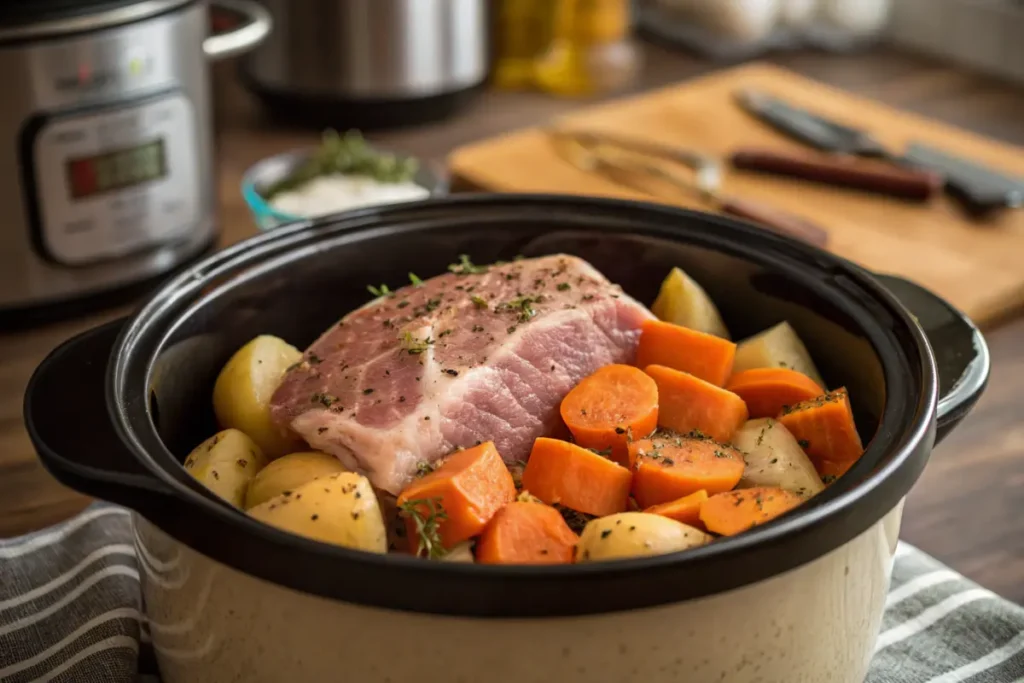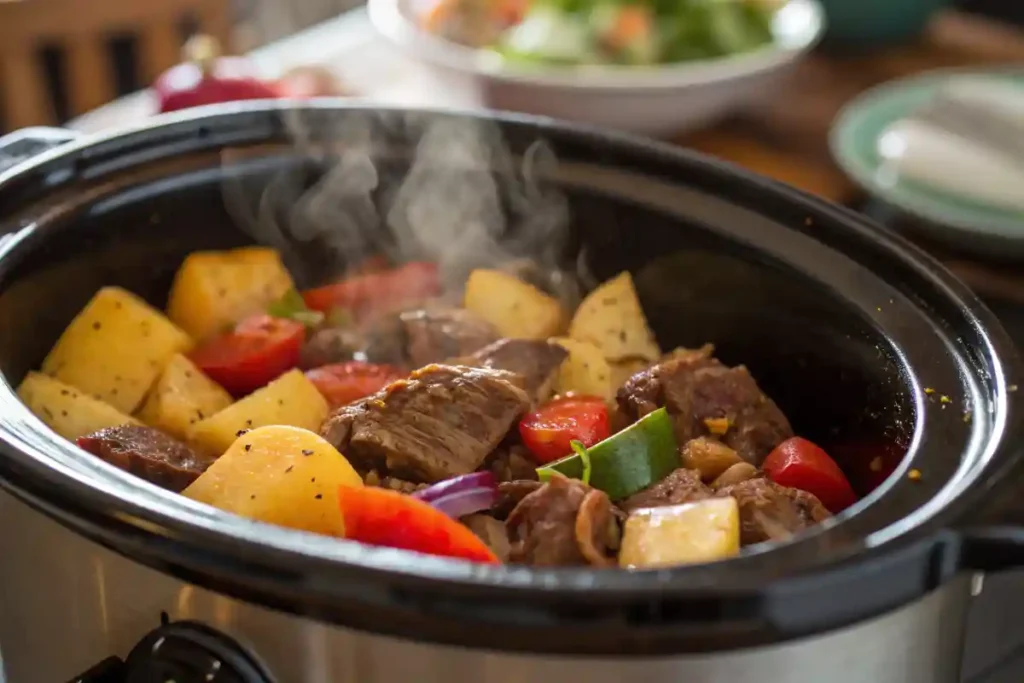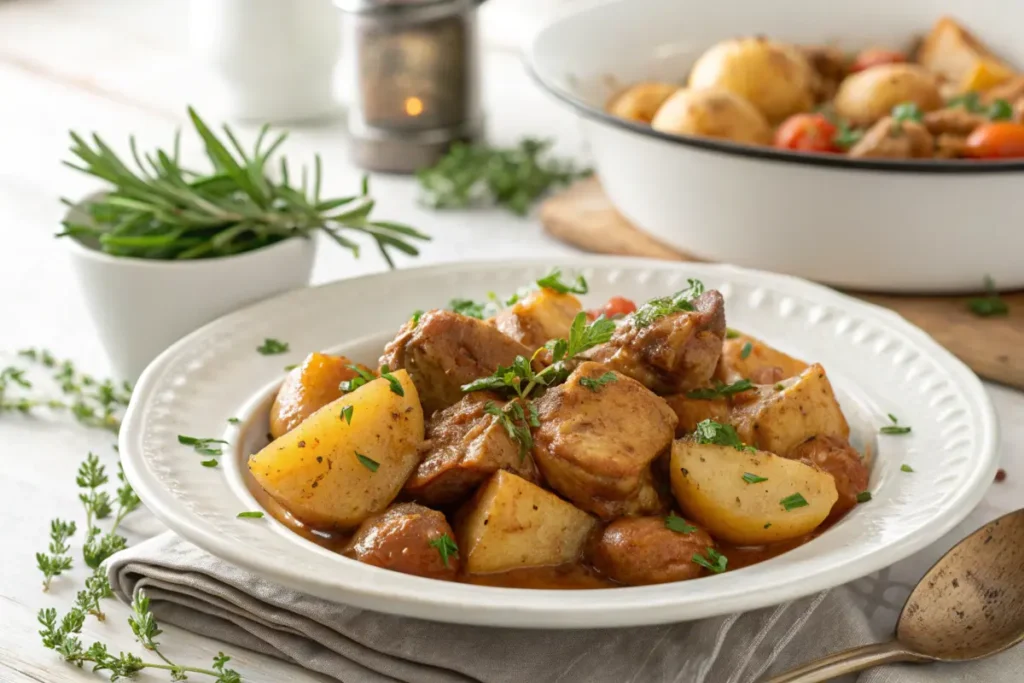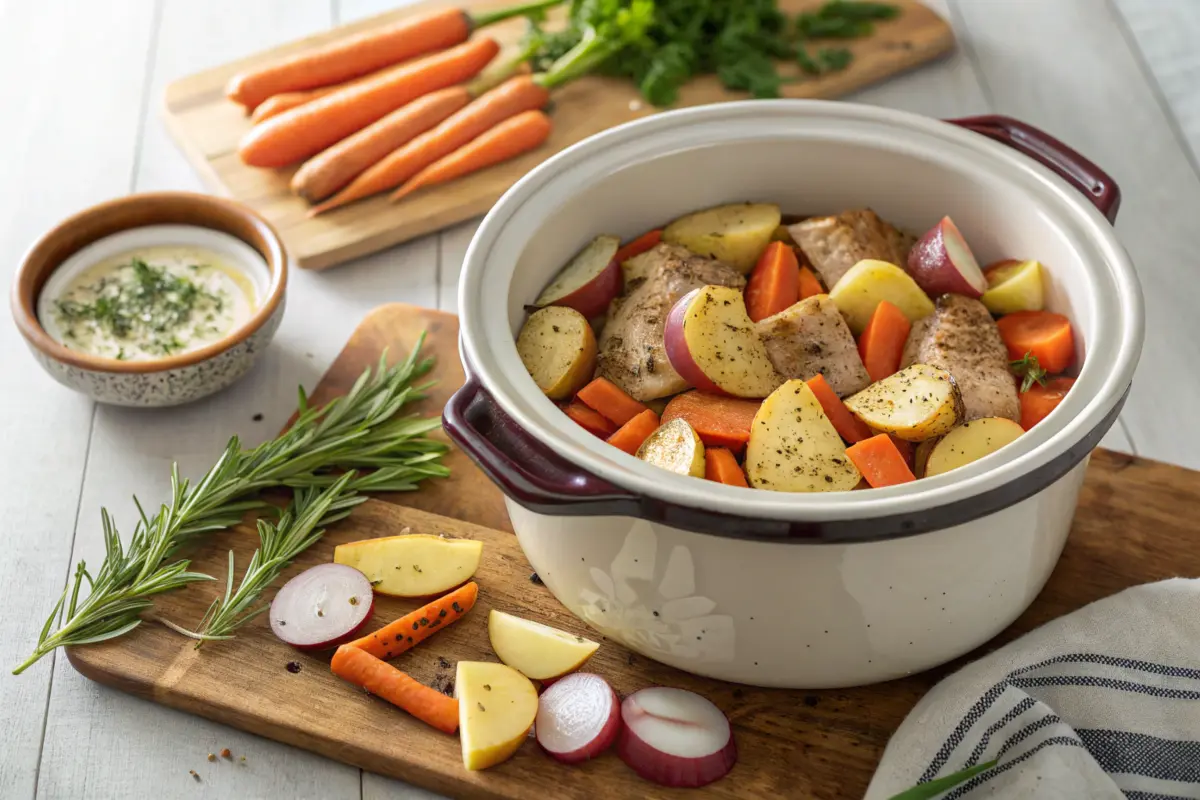Introduction
When it comes to slow cooking, the arrangement of ingredients can make or break your dish. Have you ever wondered, “Do the potatoes go under meat in a crock pot?” This might seem like a minor detail, but in reality, it impacts cooking times, flavor infusion, and even texture. Throughout this article, we’ll dive into the nitty-gritty of crock pot layering, uncover the pros and cons of different techniques, and share expert insights to help you perfect your slow-cooked meals. Do the potatoes go under meat in crock pot? Let’s get started!
Understanding Crock Pot Layering: Do the Potatoes Go Under Meat?

Crock pots, or slow cookers, have transformed how we cook hearty meals. They simplify dinner prep by gently cooking ingredients over several hours, making the process almost foolproof. However, if you’ve ever tossed everything into your crock pot haphazardly, you may have noticed uneven textures or flavors. Ingredient placement, it turns out, plays a starring role.
Placing potatoes under meat is a common practice, but it raises questions about whether this method truly optimizes flavor and doneness. Potatoes, being denser than most ingredients, require more time to cook. Positioning them at the bottom, closest to the heat source, ensures they become tender and absorb juices from the meat above. But is that always the best approach? and Do the potatoes go under meat in crock pot?
Interestingly, the answer depends on several factors, including the type of meat, the recipe, and personal preferences. Many traditional recipes suggest layering vegetables, such as potatoes, first to act as a bed for the meat. The logic here is simple: vegetables shield the meat from direct heat and create a flavorful base that enhances the dish.
However, some cooks argue for the reverse layering approach, placing meat directly on the bottom. They claim this method helps sear and caramelize the meat’s exterior, locking in flavors better. On the other hand, this might result in overcooked potatoes.
The layering order affects more than taste. It impacts texture, cooking efficiency, and how flavors meld during the long cooking process. In the sections ahead, we’ll explore how this simple question of placement opens the door to diverse culinary techniques and ideas. Whether you prefer classic comfort food or experimenting with flavors, there’s a perfect layering method for you.
The Basics of Crock Pot Cooking
How a Crock Pot Works
The magic of a crock pot lies in its simplicity. A crock pot is designed to cook food slowly and evenly, using low and consistent heat. The ceramic or metal container within the appliance retains and radiates heat, creating a moist cooking environment. This process allows ingredients to cook gently, breaking down tough fibers in meats and vegetables, making dishes tender and flavorful.
A crucial detail in the crock pot’s function is the heat source, located at the base or surrounding the cooking vessel. Heat rises from the bottom and circulates around the pot. As a result, ingredients at the bottom are exposed to higher temperatures earlier, while those on top receive less direct heat until the cooking progresses. This is where ingredient placement becomes pivotal.
Unlike stovetop or oven cooking, where stirring or flipping is routine, crock pots require minimal intervention. Because the lid must remain sealed to trap heat and moisture, what goes in first stays there until serving time. This means the sequence and placement of ingredients directly impact the final texture and flavor of your dish.
Importance of Ingredient Placement in Slow Cooking
The positioning of ingredients in a crock pot isn’t random; it’s strategic. Denser items like potatoes, carrots, and other root vegetables typically take longer to cook. Placing them at the bottom ensures they receive the most heat, allowing them to soften and absorb the flavorful juices dripping down from meats or sauces above.
On the other hand, proteins such as chicken or beef often cook faster and release juices that enhance the overall dish. If these proteins are layered incorrectly, they can overcook, becoming dry and chewy, while the vegetables remain underdone.
Additionally, the layering technique helps flavors meld during the slow cooking process. The savory essence of meat, for example, seeps into the vegetables below, creating a harmonious blend of tastes. Conversely, vegetables layered on top may retain a fresher texture and flavor, depending on the desired outcome.
In short, understanding how heat interacts with your ingredients and tailoring your layering accordingly is the key to mastering the art of slow cooking. Let’s explore these methods more deeply by examining how to layer potatoes and meat effectively in the next section, and Do the potatoes go under meat in crock pot?
Layering Potatoes and Meat in a Crock Pot

Traditional Layering Techniques
For decades, traditional crock pot recipes have emphasized layering as a foundational step. The standard advice is to place vegetables, particularly denser ones like potatoes and carrots, at the bottom of the pot. This provides a cushion for the meat, preventing direct contact with the heat source, which could cause burning or overcooking.
The middle layer typically houses the protein, such as beef, pork, or chicken. This setup allows the meat’s juices to drip down into the vegetables, enhancing their flavor while keeping the protein moist. Finally, delicate ingredients like tomatoes, soft vegetables, or grains go on top, ensuring they don’t overcook or disintegrate.
While this classic approach works well for most recipes, modern cooks have started experimenting with variations. Some reverse the order, placing meat at the bottom for caramelization or improved browning. Each method has its advantages, depending on the dish’s goals and the type of ingredients used.
Placing Potatoes Under Meat: Pros and Cons

Placing potatoes at the bottom of the crock pot is a widely accepted method for good reason. Potatoes, being dense and starchy, benefit from maximum heat exposure. This positioning ensures they cook evenly, avoiding the unpleasant crunch of undercooked centers. Additionally, potatoes at the bottom absorb flavorful drippings from the meat above, adding richness to their taste.
However, this method isn’t without drawbacks. Potatoes at the bottom can sometimes become too soft or mushy, especially during extended cooking times. Over time, their starch may thicken the cooking liquid excessively, altering the texture of the dish.
Another consideration is flavor balance. While the meat juices enhance the potatoes, the reverse is not always true. Potatoes may release starch into the meat, diluting its natural flavors. This trade-off might not appeal to everyone, depending on personal taste preferences.
Placing Meat Under Potatoes: Pros and Cons
The alternative method, placing meat under potatoes, flips the traditional approach. This technique works well for dishes where you want the meat to develop a slightly browned crust or a firmer texture. Meat positioned closer to the heat source can sear or caramelize slightly, adding depth to its flavor.
However, this method risks overcooking the meat. If it remains too long in direct contact with the heat source, the protein may dry out. Additionally, juices from the potatoes above may drip onto the meat, diluting its robust flavor and making the dish less savory.
In some cases, placing meat under potatoes can also lead to uneven cooking. The potatoes on top may not receive sufficient heat, resulting in inconsistent textures. While this method suits certain recipes, it’s not universally ideal.
In conclusion, both layering approaches have their merits and drawbacks. The choice often comes down to the type of ingredients, desired textures, and the specific recipe being used. With a better grasp of these techniques, you’re one step closer to perfecting your slow-cooked meals.
Factors Influencing Layering Decisions
Type of Meat and Its Cooking Time
When deciding the layering in a crock pot, the type of meat being used is a significant factor. Different meats have varying cooking times and textures, influencing how they should be positioned within the pot. For instance, tougher cuts like beef chuck or brisket require longer cooking times to break down the connective tissue. Placing such meats on the bottom, where they can benefit from direct heat, ensures they become tender and flavorful.
On the flip side, leaner cuts like chicken breasts or pork tenderloin cook faster. Placing these on top of potatoes or vegetables prevents overcooking, maintaining their moisture and taste. Additionally, leaner meats can absorb the juices from the ingredients below, enhancing their flavor.
In multi-protein recipes, like those combining chicken and beef, strategic placement is essential. Slower-cooking proteins should be closer to the heat source, while quicker-cooking ones should sit above. Balancing cooking times for mixed proteins ensures all components reach their peak tenderness simultaneously.
Characteristics of Potatoes in Slow Cooking
Potatoes, with their dense and starchy structure, behave differently in a crock pot compared to other vegetables. Russet or Yukon Gold potatoes, for example, break down more easily, making them perfect candidates for soups or stews where a creamy texture is desired. In such cases, placing them at the bottom is ideal as they’ll absorb both heat and the flavors of the surrounding ingredients.
However, waxy potatoes like red or fingerlings hold their shape better during long cooking times. These are ideal for dishes requiring distinct textures. When placed at the bottom, they’ll cook evenly without disintegrating, but layering them higher up can also work if you want them slightly firmer.
Potatoes also absorb liquids and spices effectively, which means their placement affects not just their texture but the overall flavor profile of the dish. If you prefer deeply seasoned potatoes, placing them at the bottom ensures they soak up the broth or meat juices. On the other hand, for lighter, fresher flavors, placing them higher may be more suitable.
Desired Texture and Flavor Outcomes
The final texture and flavor of your dish hinge on the arrangement of ingredients. For example, placing meat directly on the bottom can create a seared-like effect due to its proximity to heat. This method is great for dishes where caramelization or a robust meat flavor is the goal.
Conversely, placing potatoes at the bottom allows them to cook until soft and absorb the savory juices from the meat above, resulting in a richer flavor. If you prefer your potatoes with a firmer bite, positioning them higher in the pot might yield better results.
The layering decision also impacts flavor melding. Ingredients layered closer to one another interact more intensely during the slow cooking process, leading to a deeper integration of tastes. For stews or soups, this is ideal, but for recipes where distinct flavors are preferred, spacing out ingredients through strategic layering is key.
Ultimately, understanding the characteristics of each ingredient and their interaction with the crock pot’s heat source empowers you to tailor your meals to your preferences.
Expert Recommendations
Culinary Experts’ Opinions on Layering
Many culinary professionals agree that the key to successful crock pot meals lies in the layering technique. Renowned chefs and food bloggers emphasize placing hard vegetables like potatoes and carrots at the bottom, as these require the most cooking time and thrive under direct heat. According to experts, this positioning not only ensures even cooking but also enhances the potatoes’ flavor by allowing them to soak up juices and spices.
Some experts, however, advocate for experimenting with meat placement. Placing meat on the bottom can develop richer flavors through caramelization, especially in recipes calling for braised or roasted-like textures. Yet, this approach often works best for shorter cooking times or leaner cuts of meat.
Additionally, several slow-cooking aficionados recommend layering ingredients in a specific sequence based on their cooking needs: denser items first, proteins next, and delicate or quick-cooking items on top. This method minimizes overcooking while maximizing flavor.
Best Practices for Layering Meat and Potatoes
From expert advice, several best practices emerge:
- Balance Cooking Times: Consider the density and cooking requirements of each ingredient. Layer potatoes and root vegetables on the bottom to ensure they become tender, while quicker-cooking proteins sit higher up to avoid overcooking.
- Flavor Fusion: Position ingredients strategically to enhance flavor. For example, placing potatoes under meat allows them to absorb the savory juices dripping down, enriching their taste.
- Use Broth Wisely: Adding liquid like broth or stock ensures even cooking and prevents burning at the bottom. Pouring it over the top distributes flavors uniformly.
- Don’t Overfill: Overpacking the pot can lead to uneven cooking. Leave space for heat circulation and steam, ensuring all ingredients cook properly.
Another crucial tip is to adapt your layering based on the recipe. For a stew, prioritize flavor melding by layering densely packed ingredients. In contrast, for a casserole-style dish, consider separating layers for distinct textures.
By following these best practices and insights from culinary experts, you can elevate your crock pot dishes, achieving both delicious textures and harmonious flavors.
Practical Tips for Optimal Results
Preparing Potatoes for Slow Cooking
When it comes to preparing potatoes for a crock pot dish, size and type matter. For recipes requiring soft, creamy potatoes, opt for starchy varieties like Russet or Yukon Gold. If the goal is firmer potatoes that hold their shape, waxy types such as red or fingerling potatoes are ideal.
To ensure even cooking, cut potatoes into uniform pieces. Larger chunks work well for dishes that cook for extended hours, as they’re less likely to disintegrate. For quicker recipes, smaller pieces reduce cooking time and infuse more flavor. Peeling is optional; the skins add texture and nutrients but can be omitted for smoother results.
Another essential tip is to pre-soak potatoes in cold water for 20–30 minutes before adding them to the crock pot. This removes excess starch, preventing them from clumping together or turning gummy during cooking. Seasoning potatoes with salt, pepper, or herbs before layering them adds depth to their flavor.
Preparing Meat for Slow Cooking
Preparing meat for slow cooking involves a balance between enhancing flavor and ensuring tenderness. First, choose cuts of meat that are well-suited for slow cooking, such as beef chuck, pork shoulder, or chicken thighs. These cuts benefit from low-and-slow cooking, which breaks down tough fibers and connective tissues.
For optimal flavor, consider searing the meat before placing it in the crock pot. While not mandatory, browning creates a caramelized crust that adds complexity to the dish. Use a hot skillet with a splash of oil, sear the meat for a few minutes on each side, and then transfer it to the crock pot.
Trimming excess fat is another critical step. Too much fat can make the dish greasy, but leaving a thin layer helps keep the meat moist. For seasoning, apply marinades, dry rubs, or simple salt and pepper liberally. Remember, the slow cooking process will amplify these flavors.
Adjusting Cooking Times Based on Layering
The arrangement of ingredients directly impacts cooking time. When potatoes are placed at the bottom, they cook faster because they’re exposed to direct heat. Adjustments might be necessary for recipes where potatoes cook too quickly and risk turning mushy. For firmer potatoes, reduce the overall cooking time or cut them into larger pieces.
For meat placed on top, extending cooking times may be required, especially for tougher cuts. In contrast, lean meats on the top layer may need reduced cooking times to avoid drying out.
Layering delicate vegetables like tomatoes or zucchini at the top protects them from overcooking. To ensure even cooking, occasionally rotate the crock pot during the process, especially if your model has uneven heat distribution. Lastly, avoid the temptation to lift the lid frequently. Each time the lid is opened, heat escapes, and cooking times extend by 20–30 minutes.
By carefully preparing your ingredients and making slight adjustments based on layering, you can achieve perfectly cooked meals every time.
Frequently Asked Questions
Do the potatoes go under meat in crock pot?
Yes, potatoes can become mushy if overcooked or cut into small pieces. To prevent this, use waxy potatoes and cut them into larger chunks. Placing them on top of other ingredients can also help them retain their shape.
Do you need to layer vegetables under meat?
Layering vegetables like potatoes under meat is recommended because it exposes them to direct heat, ensuring they cook evenly. This also allows the vegetables to soak up the juices from the meat, enhancing flavor.
What happens if you overcook potatoes in a crock pot?
Overcooked potatoes can disintegrate and become overly soft, turning the dish’s texture starchy or gummy. To avoid this, monitor cooking times closely and use the appropriate potato variety for your recipe.
How do you ensure even cooking in a crock pot?
To ensure even cooking, layer denser items like potatoes at the bottom, balance liquid levels, and avoid overloading the pot. Using uniform ingredient sizes and rotating the pot (if needed) can also improve results.
With these tips and answers, mastering the art of crock pot cooking becomes an enjoyable and rewarding process!
Conclusion
In conclusion, the answer to the question “Do the potatoes go under meat in a crock pot?” lies in the recipe, the ingredients, and your desired outcome. For most dishes, placing potatoes under the meat ensures they cook evenly and absorb flavorful juices, making them soft and savory. This traditional approach is a favorite for hearty stews and casseroles, where melding flavors take center stage.
However, alternative methods, such as layering meat first, can offer unique textures and tastes, especially in recipes prioritizing caramelization or firmer potatoes. The key is understanding how ingredient placement affects cooking times, textures, and flavors. By tailoring your approach to the type of meat, potatoes, and your specific dish, you can achieve exceptional results.
Mastering crock pot layering transforms a simple slow-cooked meal into a culinary triumph, making every dish as enjoyable to prepare as it is to savor.

